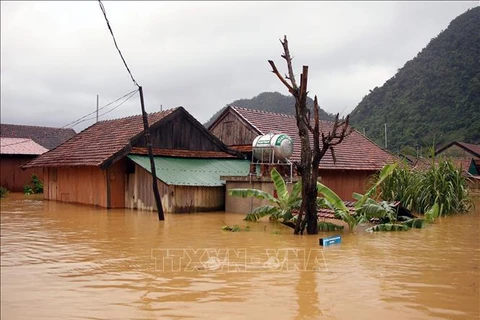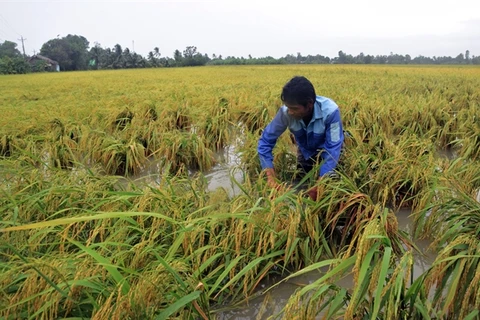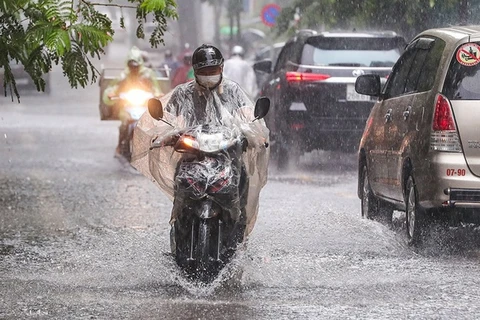Hanoi (VNS/VNA) - Natural disasters are becoming more unpredictable and extreme due to climate change, causing more extensive damage to people and property.
In Vietnam, since the beginning of this year, natural disasters have been increasingly irregular, with unseasonal rains and flooding accompanied by thunderstorms, strong winds and storms.
From March 30 to April 2, heavy rain in the central region caused widespread damage, especially to agricultural production.
From April 15 to 28, 41 earthquakes were recorded in Kon Plong district in the Central Highlands province of Kon Tum.
In April, May and mid-June, prolonged downpours pushed water levels in the north to historic highs.
Such torrential rain has led to landslides and flash floods in mountainous areas, as well as flooding in urban areas and industrial zones, especially in Hanoi, Vinh Yen, Bac Ninh and Bac Giang.
The water level on a number of rivers rose to alarming Level two and three (five is the highest), threatening the safety of the dyke system.
From the beginning of this year to August 13, 82 people were killed or went missing due to natural disasters, and economic losses were estimated at over 4 trillion VND (171.8 million USD), according to the National Steering Committee for Natural Disasters Prevention and Control.
Speaking about the natural disasters, especially heavy rain, flash floods and landslides, Deputy Director of the Vietnam Disaster Management Authority (VDMA) Nguyen Van Tien said that they were getting worse because of climate change.
Another reason is limited awareness of the authorities and people in some places. They did not have specific solutions and had not made appropriate investments in disaster prevention and control.
Over-exploitation of sand caused erosion of riverbanks and coasts. Forest exploitation reduced the vegetation layer and the natural ecosystem became unbalanced.
Tien said that most local disaster prevention and control forces had to spend their time on multiple tasks. They lack specialised equipment and tools for monitoring and supervision. As a result, they struggled to respond to large-scale disasters.
The use of technology and databases in natural disaster prevention and control is still limited, especially for flash floods and landslides.
Improve forecasting capacity
Minister of Agriculture and Rural Development Le Minh Hoan, who is also deputy head of the Standing Committee of the National Steering Committee for Natural Disaster Prevention and Control, said that to reduce risks and damage caused by natural disasters, all authorities should perfect the legal system for the work.
They should develop appropriate strategies and warning maps, perform forest protection, and control investment in construction projects for climate change.
They should also ensure the quality of early warnings and forecasting to proactively prevent and minimise damage.
To improve forecasting, the hydro meteorological sector has extended the time limit for weather forecasting and warning for natural disasters to 10 days.
Seasonal forecasting period is also extended. The sector has a newsletter identifying natural disasters, issued twice a year.
Forecasts for storms and tropical depressions are issued three or five days in advance, forecasts for heavy rain two or three days, and warnings for thunderstorms released from 30 minutes to two hours in advance. Severe cold spells are forecast five to seven days in advance.
Marine weather forecasting has seen remarkable innovations thanks to new foreign technologies. Wave forecasting models have been detailed within four kilometres, and the forecast period is up to 10 days.
The time of issuing storm bulletins is 30 minutes to one hour earlier than before. Other reports, such as hot or cold weather and heavy rain are issued 30 minutes earlier than before.
VDMA Director Tran Quang Hoai said that in responding to natural disasters, ministries and localities needed to closely monitor the evolution of natural disasters, especially flash floods and landslides in mountainous areas.
They must protect the dyke systems, reservoirs and dams, promptly and accurately advise the National Steering Committee for Natural Disaster Prevention and Control to direct concerned agencies to respond to and overcome the consequences of natural disasters.
The national steering committee needs to guide and urge localities to implement provincial indicators for assessing disaster prevention and control this year.
The committee should build a monitoring system for drought and saltwater intrusion in the Mekong Delta, review and propose adjustments to the master plan on flood prevention and control in the Hong Red and Thai Binh river systems.
In the future, the VDMA will strengthen science and technology application in disaster management, aiming to build a national database and tools for monitoring and supporting the work.
It will call for resources from domestic and foreign agencies and organisations to conduct international treaties which Vietnam has signed.
The VDMA will develop social networks such as Facebook, Zalo, Youtube and Tiktok with attractive programmes and news, increasing interactivity and attracting users.
This year, the VDMA will finalise the administrative reform plan and strengthen information technology to handle work to improve efficiency in natural disaster prevention and control.
It will focus on training and fostering skills for staff, evaluating and replicating typical models in natural disaster prevention and control./.
In Vietnam, since the beginning of this year, natural disasters have been increasingly irregular, with unseasonal rains and flooding accompanied by thunderstorms, strong winds and storms.
From March 30 to April 2, heavy rain in the central region caused widespread damage, especially to agricultural production.
From April 15 to 28, 41 earthquakes were recorded in Kon Plong district in the Central Highlands province of Kon Tum.
In April, May and mid-June, prolonged downpours pushed water levels in the north to historic highs.
Such torrential rain has led to landslides and flash floods in mountainous areas, as well as flooding in urban areas and industrial zones, especially in Hanoi, Vinh Yen, Bac Ninh and Bac Giang.
The water level on a number of rivers rose to alarming Level two and three (five is the highest), threatening the safety of the dyke system.
From the beginning of this year to August 13, 82 people were killed or went missing due to natural disasters, and economic losses were estimated at over 4 trillion VND (171.8 million USD), according to the National Steering Committee for Natural Disasters Prevention and Control.
Speaking about the natural disasters, especially heavy rain, flash floods and landslides, Deputy Director of the Vietnam Disaster Management Authority (VDMA) Nguyen Van Tien said that they were getting worse because of climate change.
Another reason is limited awareness of the authorities and people in some places. They did not have specific solutions and had not made appropriate investments in disaster prevention and control.
Over-exploitation of sand caused erosion of riverbanks and coasts. Forest exploitation reduced the vegetation layer and the natural ecosystem became unbalanced.
Tien said that most local disaster prevention and control forces had to spend their time on multiple tasks. They lack specialised equipment and tools for monitoring and supervision. As a result, they struggled to respond to large-scale disasters.
The use of technology and databases in natural disaster prevention and control is still limited, especially for flash floods and landslides.
Improve forecasting capacity
Minister of Agriculture and Rural Development Le Minh Hoan, who is also deputy head of the Standing Committee of the National Steering Committee for Natural Disaster Prevention and Control, said that to reduce risks and damage caused by natural disasters, all authorities should perfect the legal system for the work.
They should develop appropriate strategies and warning maps, perform forest protection, and control investment in construction projects for climate change.
They should also ensure the quality of early warnings and forecasting to proactively prevent and minimise damage.
To improve forecasting, the hydro meteorological sector has extended the time limit for weather forecasting and warning for natural disasters to 10 days.
Seasonal forecasting period is also extended. The sector has a newsletter identifying natural disasters, issued twice a year.
Forecasts for storms and tropical depressions are issued three or five days in advance, forecasts for heavy rain two or three days, and warnings for thunderstorms released from 30 minutes to two hours in advance. Severe cold spells are forecast five to seven days in advance.
Marine weather forecasting has seen remarkable innovations thanks to new foreign technologies. Wave forecasting models have been detailed within four kilometres, and the forecast period is up to 10 days.
The time of issuing storm bulletins is 30 minutes to one hour earlier than before. Other reports, such as hot or cold weather and heavy rain are issued 30 minutes earlier than before.
VDMA Director Tran Quang Hoai said that in responding to natural disasters, ministries and localities needed to closely monitor the evolution of natural disasters, especially flash floods and landslides in mountainous areas.
They must protect the dyke systems, reservoirs and dams, promptly and accurately advise the National Steering Committee for Natural Disaster Prevention and Control to direct concerned agencies to respond to and overcome the consequences of natural disasters.
The national steering committee needs to guide and urge localities to implement provincial indicators for assessing disaster prevention and control this year.
The committee should build a monitoring system for drought and saltwater intrusion in the Mekong Delta, review and propose adjustments to the master plan on flood prevention and control in the Hong Red and Thai Binh river systems.
In the future, the VDMA will strengthen science and technology application in disaster management, aiming to build a national database and tools for monitoring and supporting the work.
It will call for resources from domestic and foreign agencies and organisations to conduct international treaties which Vietnam has signed.
The VDMA will develop social networks such as Facebook, Zalo, Youtube and Tiktok with attractive programmes and news, increasing interactivity and attracting users.
This year, the VDMA will finalise the administrative reform plan and strengthen information technology to handle work to improve efficiency in natural disaster prevention and control.
It will focus on training and fostering skills for staff, evaluating and replicating typical models in natural disaster prevention and control./.
VNA

























